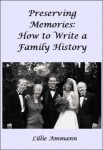November is Family Stories Month and National Life Writing Month.
I remember as a young child my grandfather telling stories about his days as a cowboy. On holidays when the big extended family gathered to celebrate, he regaled us with his exploits.
No one ever bothered to write the stories down. Grandpa was always telling his stories. While we loved to hear them, neither adults or children thought ahead to the time he would be gone–and his stories with him.
I encourage everyone to write their life story. There are many ways you can tell your story:
- a personal memoir, such as George’s Rendezvous with Destiny, by World War II vet George Vakey; or Base Jumping, by a man who grew up as a military brat; or My Life Story: Adventures of the Great Dane, by a man from Denmark who spent his life in the merchant marine and the United States military
- a personal journal, such as Journal: Intimate Writings of a Relationship with God, by a devout Christian, or a book about how something specific affected your life, such No! Not Again!, by a mother who has experienced the death of two of her children
- a family history or a fictionalized family history, such as The Westward Sagas, by genealogy/family history enthusiast David Bowles
- a collection of anecdotes, such as the book I wrote about my husband Jack
- a unique combination of memoir and family letters and poems, such as Some Monument to Last, by TV journalist James (Munoz) Doughty
- a video interview of the oldest family member or a photo collection with descriptions of who are in the photos and what they are doing
- a recipe book, such as the project I’m working on now for a family who has fond recollections of many happy family meals; you could even add special memories with each recipe
You don’t have to publish your memories for the world to read. With digital printing today, you can print 50 or 100 copies for family and friends and never make the book available to the general public. Or you can simply print out a few copies on your computer.
My mother wrote what she called her “little stories” as she remembered something from her life. The stories were completely random in order–she might write about an experience from her childhood then a memory from her later years. I typed up the stories and added photos. Each Christmas, we printed copies for my siblings and me to add to the three-ring binder Mom had given us to start the project. Even the grandkids looked forward to Grandma’s stories each Christmas.
My mother-in-law dictated her stories into a tape recorder. I typed them and added photos, printed the documents, and inserted the pages into three-ring binders to distribute to family members.
Those memories are so precious today, years after their deaths. Reading those stories reminds us of those special women we love so much and of things we never thought we’d forget–but have forgotten.
This month is a wonderful time to start your family story or life writing project. If you’re spending Thanksgiving with family, share favorite memories and ask someone to write them down.
 You’ll find help to write your memoir or family history in my short ebook–Preserving Memories: How to Write a Family History.
You’ll find help to write your memoir or family history in my short ebook–Preserving Memories: How to Write a Family History.
Unless you and/or your family are famous or infamous, the general public isn’t likely to be interested in your story. However, your family members in this generation and generations to come will love remembering or learning about you and your family.

